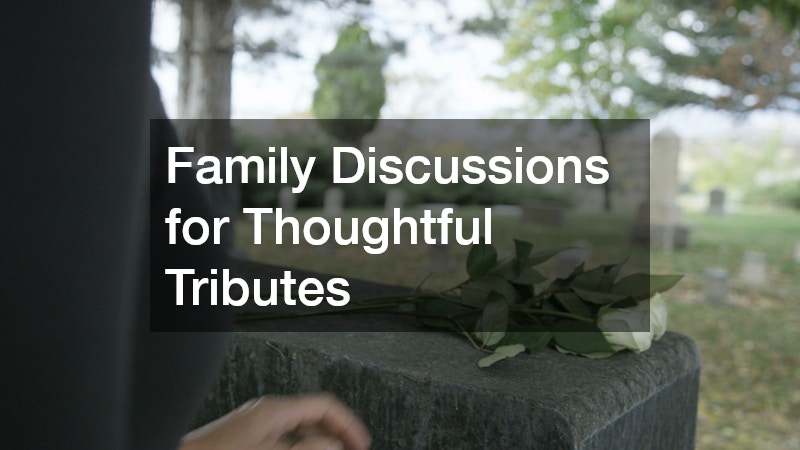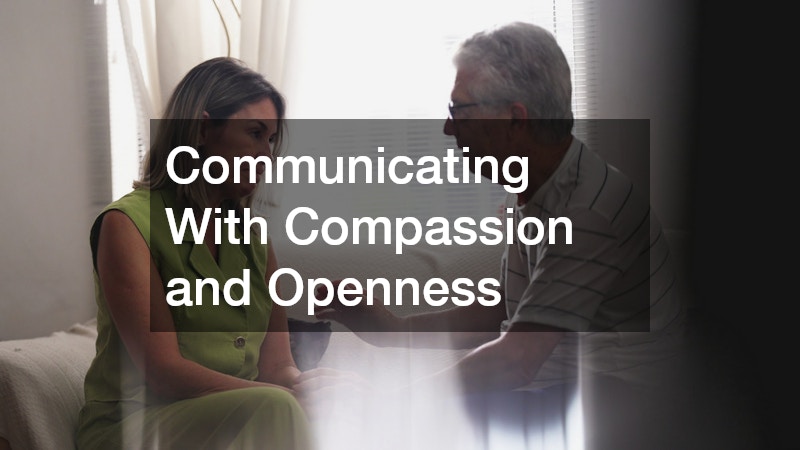Planning a funeral is one of the most sensitive and emotionally challenging tasks a family can face. These discussions often bring up grief, uncertainty, and deeply personal questions about how to honor a loved one’s life. Yet, involving family members early and openly can make the process more manageable and meaningful. Including loved ones in funeral planning discussions ensures everyone’s wishes are considered, strengthens family bonds, and reduces the stress of decision-making during difficult times. It’s essential to approach these conversations with empathy, patience, and clarity.
The first step is to establish a safe and calm environment for discussion. Choose a time when family members can focus without distractions, and be mindful of emotional readiness. Introduce the topic gently, emphasizing that the goal is to honor the wishes of the person for whom you are planning. Encourage open dialogue and make it clear that all opinions are valid. Sharing personal stories or reflecting on the life of the loved one can help ease into the conversation, making it less clinical and more heartfelt. This emotional context can be especially helpful for younger family members who may struggle to engage in logistical discussions without understanding the significance.
Creating a structure for the conversation is also important. Start by outlining key areas that require input, such as funeral services, memorial preferences, and any practical considerations. Assigning specific topics to different family members can help avoid overwhelm and ensure everyone contributes. For instance, one person might research funeral service options, while another gathers information about sympathy flowers or custom picture frames to display during the ceremony. By dividing responsibilities, the planning process becomes collaborative rather than burdensome. Open communication and clear expectations help prevent misunderstandings and ensure that each family member feels respected and heard throughout the process.
Discussing Hospice and End-of-Life Wishes

For families navigating the final stages of a loved one’s life, hospice care often becomes a central part of the conversation. Including hospice in planning discussions allows families to address both medical and emotional needs, ensuring that end-of-life care aligns with the individual’s values and comfort. Hospice professionals can provide guidance on pain management, palliative support, and emotional resources, which may influence funeral preferences or memorial choices. Engaging in these conversations early can prevent last-minute decisions made under stress and allow loved ones to focus on meaningful moments rather than logistics.
When discussing hospice, it’s helpful to frame the conversation around quality of life and personal dignity. Encourage the loved one to express their wishes regarding comfort measures, visitation preferences, and any rituals or practices they value. Family members should listen actively, acknowledge feelings, and validate concerns. This approach fosters trust and ensures that the individual’s voice remains central throughout the planning process. Additionally, including hospice staff in family meetings can provide clarity on practical considerations, such as the timing of services and coordination with funeral homes or other providers.
It’s also important to consider how hospice care may intersect with legal and administrative matters. Conversations about wills and trust arrangements often occur alongside discussions of end-of-life care. While these topics can feel separate from funeral planning, addressing them together helps families create a comprehensive plan. Consulting a family attorney during this stage can clarify legal obligations, reduce potential conflicts, and provide guidance on honoring the loved one’s final wishes. By integrating hospice discussions into broader funeral planning, families can navigate this difficult period with compassion, organization, and a focus on what matters most.
Incorporating Funeral Services Preferences
Funeral services are at the heart of memorial planning, providing a structured opportunity to honor a loved one and offer comfort to those grieving. When including family members in these discussions, it’s crucial to explore preferences collaboratively and respectfully. This can involve decisions about the type of service, venue, order of events, and cultural or religious traditions that hold personal significance. Open dialogue ensures that each family member feels represented while respecting the wishes of the deceased.
Begin by reviewing available funeral services in your area and comparing options. Discuss whether the ceremony will be traditional, religious, secular, or a hybrid approach. Include details such as music, readings, and speakers. Encouraging loved ones to share personal anecdotes or memories can help shape a service that feels authentic and heartfelt. It’s also helpful to identify practical aspects such as guest lists, transportation, and timing to ensure smooth coordination. Collaboration at this stage can prevent misunderstandings and reduce stress during what is often an emotionally charged period.
Family involvement in funeral service planning can also extend to tangible elements that make the event memorable. For example, selecting sympathy flowers that reflect the loved one’s personality or arranging for custom picture frames to display cherished memories can provide comfort and personalization. By allowing family members to contribute creatively, the service becomes a shared expression of remembrance. Encouraging open communication throughout this process ensures that funeral services honor the deceased while fostering unity and support among those left behind.
Family Discussions for Thoughtful Tributes

Another important aspect of funeral planning discussions is selecting memorials and monuments. These physical tributes serve as lasting reminders of a loved one’s life and legacy. Including family members in these decisions allows for meaningful input on style, inscriptions, and placement. It also ensures that the memorial reflects the personality and values of the deceased, rather than being chosen solely for convenience or tradition.
Families can choose a grave marker collaboratively, balancing aesthetics, durability, and personal significance. Considering inscriptions, symbols, or photographs that tell a story or highlight cherished memories allows everyone to contribute meaningfully. Open discussions about important decisions like grave marker choices being made for loved ones can prevent disagreements and ensure that a loved one is honored in a way that feels both respectful and personal. Planning these details carefully helps the memorial remain a source of pride and reflection for years to come.
When selecting a flat headstone, families might focus on size, shape, and materials that fit both the location and the wishes of the deceased. Including multiple generations in these conversations encourages shared understanding and continuity of family traditions. Discussing plans for cleaning, upkeep, or restoration at this stage ensures the headstone maintains its appearance and longevity over time.
Collaborating on memorials and monuments also allows families to reflect on broader cultural practices or personal traditions. Exploring historical styles, meaningful symbols, or materials that hold significance can make the tribute more personal. By combining practical considerations with thoughtful touches, families can create lasting tributes that honor a loved one’s life, provide comfort to those grieving, and serve as meaningful reminders of their legacy.
Managing Sympathy Flowers and Ceremony Details
Sympathy flowers play an important role in funerals, offering a visual expression of love, respect, and condolence. Involving family members in the selection process ensures that arrangements reflect both the personality of the deceased and the wishes of those attending the service. Consider discussing flower types, colors, and arrangements to convey the appropriate tone and sentiment for the ceremony. This collaborative approach fosters inclusivity and allows family members to contribute in a meaningful way.
In addition to flowers, family members can participate in organizing other ceremony details. This may include selecting music, readings, or speakers, as well as coordinating seating and event timing. Engaging multiple perspectives helps ensure that the service runs smoothly while honoring the diverse needs and preferences of attendees. Including family in these decisions also provides an opportunity to share memories, stories, and reflections, enriching the ceremony with personal significance.
Attention to detail in planning elements such as sympathy flowers and ceremony logistics demonstrates respect for both the deceased and the grieving family. Open communication ensures that responsibilities are divided fairly, reducing stress during the preparation process. By working together on these tangible components, families create a service that is cohesive, heartfelt, and representative of the loved one’s life.
Integrating Legal and Estate Considerations

Funeral planning often intersects with broader legal and financial matters, making it important to include family attorneys and discuss wills and trust arrangements. Consulting a family attorney can clarify responsibilities, outline legal requirements, and ensure that the deceased’s wishes are carried out appropriately. This guidance can prevent conflicts and provide peace of mind during a challenging time.
Discussing wills and trust documents alongside funeral planning helps families understand who holds decision-making authority and what directives must be followed. It can also provide clarity on funding for funeral services, memorials, monuments, and related expenses. Involving legal counsel ensures compliance with regulations and supports informed decision-making. These conversations can be framed as practical steps that complement emotional considerations, helping families balance grief with responsibility.
By integrating legal considerations with funeral planning, families are better prepared to navigate complex situations while honoring the wishes of their loved one. Transparency and collaboration reduce stress and build trust, allowing family members to focus on meaningful remembrance rather than logistical uncertainty. Including attorneys and reviewing wills and trust arrangements alongside memorial decisions creates a comprehensive approach that supports both emotional and practical needs.
Personalizing Custom Picture Frames and Keepsakes
Custom picture frames and other keepsakes provide tangible ways to celebrate a loved one’s life during a funeral service. Including family members in selecting these items allows for creativity and shared expression. Decisions about which photos to display, the style of frames, and placement during services can be made collaboratively to honor the deceased authentically.
These keepsakes also provide comfort after the funeral, offering a lasting memory that family members can cherish. Custom picture frames can include photographs, messages, or mementos that reflect key moments in the loved one’s life. Encouraging participation from multiple family members ensures that the choices resonate with everyone and strengthen the sense of collective remembrance. It also provides a constructive outlet for grief, allowing family members to focus on celebrating life rather than solely mourning loss.
Beyond the ceremony itself, family discussions about keepsakes, memorials, and monuments create an ongoing connection to the deceased. By involving loved ones in these personal choices, families establish meaningful traditions and lasting tributes. These tangible items become sources of comfort, conversation, and reflection, supporting emotional healing while preserving the memory of the person who has passed.
Communicating With Compassion and Openness

Throughout funeral planning discussions, communication style is crucial. Families should prioritize compassion, active listening, and openness, allowing each member to express emotions and share perspectives without judgment. Sensitive topics, such as hospice care, funeral services, or memorial choices, often evoke strong feelings, so patience and empathy are key. Establishing clear expectations and roles reduces potential conflict and ensures that responsibilities are distributed fairly.
Encouraging all voices, including those of younger family members, strengthens family bonds and creates a sense of shared purpose. Open dialogue about headstone maintenance and other logistical details allows everyone to feel included and respected. These conversations also provide opportunities to reflect on the life of the deceased, share stories, and celebrate their legacy. By maintaining clear and compassionate communication, families create a supportive environment that facilitates meaningful collaboration.
Finally, documenting decisions and plans helps ensure clarity and continuity. Written notes or shared digital documents outlining funeral services, memorials and monuments, and other arrangements provide a reference for family members. This approach prevents misunderstandings, preserves family input, and allows all participants to feel confident that the wishes of the deceased and the family are honored.
Supporting Emotional Wellbeing During Planning
Funeral planning can be emotionally taxing, even when handled collaboratively. Families should prioritize self-care, recognize stress triggers, and seek support when needed. Involving hospice staff, grief counselors, or trusted friends can provide guidance and emotional relief. Sharing responsibilities reduces the burden on any single individual and allows everyone to process grief collectively.
Planning for memorials and monuments, arranging sympathy flowers, or discussing grave marker options may trigger intense emotions. Acknowledging these feelings and creating space for expression helps family members navigate grief while remaining engaged in planning. Encouraging breaks, offering reassurance, and fostering empathy strengthen familial connections. Emotional support is as critical as logistical preparation, ensuring that the process remains compassionate and manageable.
Ultimately, including loved ones in funeral planning discussions provides both practical and emotional benefits. Families can honor the wishes of the deceased, create meaningful services, and preserve lasting memories while maintaining emotional wellbeing. Thoughtful planning, open communication, and collaborative decision-making help transform a challenging process into a shared experience of care, reflection, and love.

